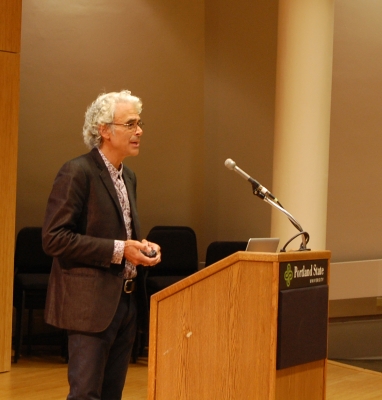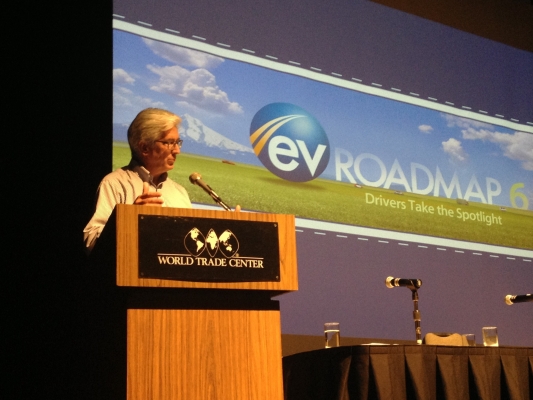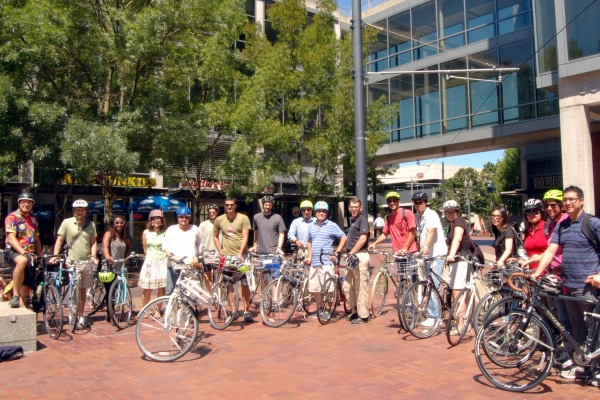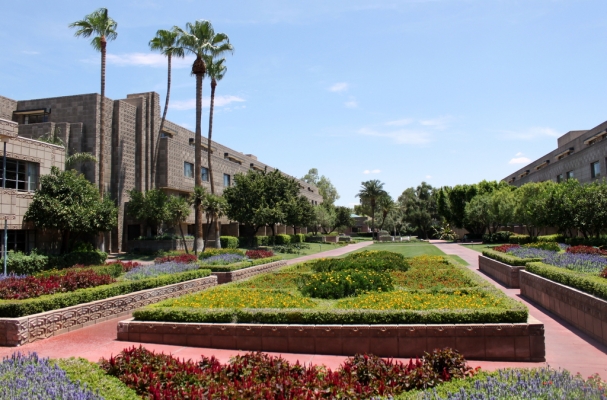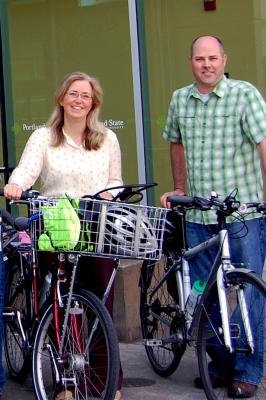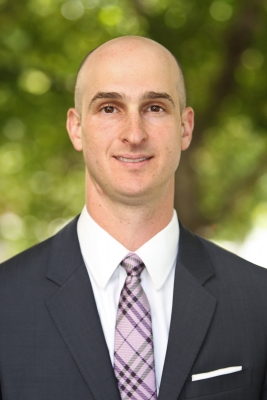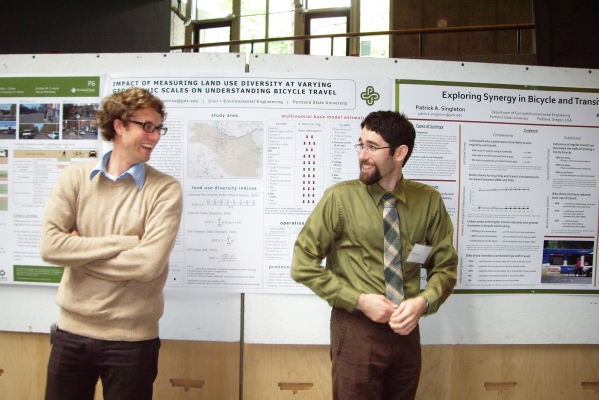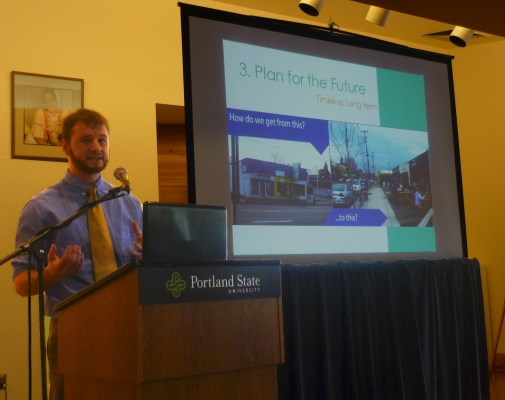John MacArthur, OTREC’s Sustainable Transportation Program Manager, was a panel moderator at this year's EVRoadmap 6 workshop.
The EV Roadmap workshop series has established itself as the Pacific Northwest’s premier electric vehicle gathering, with a goal of increasing the visibility and understanding of electric vehicles.
Co-sponsored by Portland General Electric and Portland State University, the event supports the shared goal of building a stronger, more sustainable transportation landscape.
The sixth annual EV Roadmap workshop, "Drivers Take the Spotlight," was a continuation of this fruitful partnership. The event was held at the World Trade Center in Portland on July 30-31, 2013. MacArthur moderated a panel titled "Not All Drivers Need Four Wheels." This panel focused on odd-sized electric vehicles such as e-bikes.
E-bikes are a specialty of MacArthur's; he has conducted several research studies about people's use and perceptions of the electric-assisted bicycle. His project "Evaluation of Electric Bike Use in Portland Metro Region" (click here for more information about that project, or to download the final report) focused on exploring the potential new market segments for e-bikes and the economic, operational, safety, and...
Read moreIBPI, or the Initiative for Bicycle and Pedestrian Innovation, is a center for research and learning that is focused on bicycle and pedestrian travel.
Based at Portland State University, the group's aim is to advance bicycling and walking as integral elements of the transportation system in Oregon’s communities. July 24 -26 IBPI hosted a faculty workshop to help transportation professors integrate bicycle and pedestrian topics into their courses.
Aimed at faculty members teaching transportation courses within an accredited planning or engineering program at the university level, the workshop included curriculum, guidebooks, and field trips to gain first-hand knowledge of bicycle and pedestrian facilities in Portland, Oregon.
It was kept small, to allow for discussion and interaction. The workshop's 15 participants were first given the chance to describe the existing gaps in their courses and what they hoped to gain from the workshop, then guided through a two-day series of activities tailor-made to fit their needs.
Their goals ranged from specific to general, requesting ways to incorporate GIS analysis into bicycle and pedestrian courses, suggestions for how to integrate active travel performance measures with typical vehicular performance measures, and generally a deeper understanding of bicycle research.
Robert Bertini (Portland...
Read moreOTREC was well-represented at this year’s Western ITE conference, the 2013 conference for the Western District of the Institute of Transportation Engineers. Eight graduate student researchers presented papers at the conference, which took place July 14 through 17 in Phoenix, Arizona.
Portland State University students Katherine Bell, Kirk Paulsen, Adam Moore, Wei Feng, Sirisha Kothuri, Pamela Johnson, Sam Thompson and Alex Bigazzi attended the three-day conference and showcased their work in transportation research.
The conference was held at the Arizona Biltmore, a 1920’s luxury hotel created by architects Albert Chase McArthur and Frank Lloyd Wright. For the engineering and planning students, the Biltmore held its own attraction as an example of unique architecture, and in between events they enjoyed walking the grounds.
Katherine Bell, a Master’s student whose research interests include planning, modeling and performance measures for freight, gave a presentation on the use of a smart phone application with a GPS device for...
Read moreThe 2013 Oregon Transportation Summit will take place this fall, on September 16 at Portland State University. The summit brings together transportation professionals to shape the agenda for future research, and this year's plenary speaker addresses new federal legislation which will have a direct affect on that agenda.
Adie Tomer of the Brookings Institution will deliver the remarks at the summit's morning plenary session. The topic is MAP-21, a new act which was passed by Congress in 2012. Short for "Moving Ahead for Progress in the 21st Century," the act redistributes the scope and responsibilities of transportation departments at all levels, from municipal to federal.
"What MAP-21 essentially did is, it enhanced the evolution that's available within the federal program," Tomer said. "Because it is an overarching policy, it touches on every actor in the system in a unique way." For example, "MPOs (Metropolitan Planning Organizations) are now tasked with collecting performance measurements ... and state offices are pushed to do a little more planning when it comes to freight."
Portland, Oregon is known for being a bike city, even called America's Best Bike City by Bicycling Magazine, so it's no surprise at all that Portland State University is full of bike enthusiasts.
Sirisha Kothuri, an OTREC scholar for the past two years and a current Ph.D. candidate at Portland State University, has been awarded one of NITC'S 2013 dissertation fellowships.
The $15,000 fellowship -- funded through an ISS (Institute for Sustainable Solutions) grant -- along with an $800 OTREC/NITC scholarship for the 2012-2013 academic year, will assist Kothuri with her research into pedestrian signal timing.
Sirisha was born and raised in Hyderabad, India, and still misses the heat — or at least, the warmth; she has yet to become completely acclimated to Portland, Ore weather. In Hyderabad she obtained a bachelor's degree in Civil Engineering from Osmania University in 1999. She moved to Baton Rouge, Louisiana in 1999 to get a Master’s degree in Civil Engineering at Louisiana State University.
A visit to Illinois for her brother's graduation opened her eyes to the automobile-centric cities that make up much of the United States. She was surprised at some of the infrastructure in the Midwest, which decidedly favors cars over pedestrian and other means of active transport.
Walking plays a significant...
Read moreOTREC at Portland State University is pleased to announce the 2013 OTREC/NITC scholars.
Each year, OTREC and NITC recognize outstanding students, awarding them scholarships to further their work on transportation projects.
This year's scholarship winners tackle a range of projects, including long-range visions on how to improve equity in transportation, plans for proposed facility upgrades at specific locations, investigations into new ways to strengthen pavement, and the development of advanced technologies to assist the flow of transportation in the real world.
Each year, Portland State University’s MURP, or Master’s of Urban and Regional Planning, program hosts a public presentation to showcase the work of its graduating master’s students. Students who graduate with a Master’s in Urban and Regional Planning spend the last two terms of their program collaborating on workshop projects, completing planning tasks for local clients or business organizations.
This year’s presentations took place on Wednesday, attended by a crowd of about a hundred PSU students, professors, MURP clients and community members. Six groups presented their projects. Some of the projects were transportation-focused, especially one titled "Lombard Re-Imagined."
Swift Planning Group, composed of members Kathryn Doherty-Chapman, Zef Wagner, Brian Hurley, Jake Warr, Rebecca Hamilton, and Jodi Jacobson-Swartfager, developed a plan to improve Lombard Street, a key transportation corridor in North Portland.
The challenge facing the group had to do with the many roles that Lombard street plays. The street is both an arterial throughway and a state highway. It is an overdimensional freight route, for trucks that are too big to go anywhere else in North Portland, and it has also been designated as a main street in Metro’s 2040 Growth Concept. The various...
Read more
